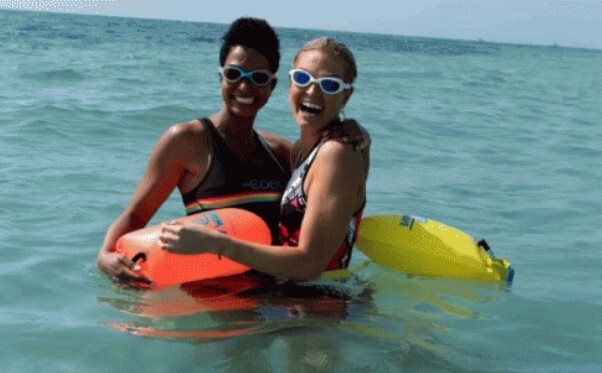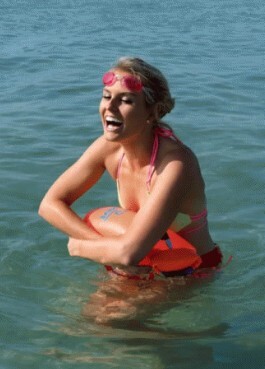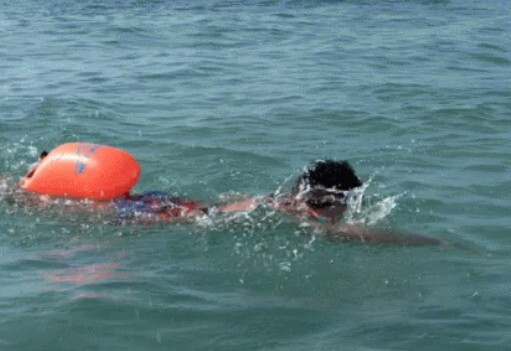Is it time to try open water swimming?
It's almost May and do you know what that means? Open water and triathlon season is here! There are some open water swims that happen during colder months, but I avoid those BURRRR (Floridian without a wetsuit).
Whether you are an open water swimmer, triathlete, or are looking to supplement your training without pool swimming (since gyms are closed) you may be thinking now is a great time to try out open water swimming in the ocean.
The first question is: Is your public beach open? If the answer is no, then it's best to follow regulations and avoid the beach. Remember, this is temporary and this too will pass.
If your beach is open or you live on the beach and have legal access (most likely this means you live on the beach), then grab your gear and hop in!
Open Water Swimming Tips & Gear:
Whether or not you are new to open water swimming, here are a few safety concerns to be aware of.
Open Water Swim Buoy:
As New Wave says, Be Bright Be Seen. Wearing an open water swim buoy is not for the purpose of being life saving, though they are fairly buoyant. The purpose is for boats, fishers and other ocean-goes to see you while swimming. Despite splashing through the water, you may not be seen with a neon green float above you. Even when swimming in groups, I will wear a buoy. It’s much easier to spot fellow swimmers instead of looking for their arms (which is very hard to see over the waves).

It does not matter how great of a swimmer you are, do not swim alone. I repeat, NO BUDDY, NO SWIMMING. I am a very experienced swimmer and would never swim alone. At a minimum, have a friend go with you and walk along the shore while you swim.
You just never know what could happen.
Know Your Water and check for rip currents-
Before you and your buddy head to the water, determine if your beach is prone or has regular rip currents.
A rip current is a type of current that pulls water from the shore out to the ocean and occurs perpendicular to the shoreline. Rip currents are so powerful that if you become stuck in one you will NOT be able to swim to the shore. They are very dangerous.
Not to Worry- Know How to Exit a Rip Current
If you are caught in a rip current, continue to swim parallel with the shore, you will be able to swim out of the current. Just another great safety reason to swim with a buddy.
Determine Your Goal Swimming in Open Water-
Now that we’ve discussed a few safety points, let’s discuss your goal. Your goal will determine the structure of your workout.
If your beach is open, you are following save COVID-19 precautions and have a buddy. You are ready to swim.
Is your Goal Speed?
If this is your goal, try interval training. You can use landmarks on the beach or if you have a timer on your watch, you can set that too. Start with intervals of swimming at a faster pace (not sprint) for about 100 yards or one minute. Then swim at a slower to medium pace for about one minute.
You can adjust these intervals based on your current swim level. You could swim 3 minutes fast and one minute slow. The main idea is to increase your pace for a set time followed by a decreased pace for a set amount of time.
Try three rounds of your interval. Rest. Try another three rounds. Adjust your intervals as needed.
Is your Goal Distance?
Do you want to swim a mile? Determine how far down the beach is half a mile. Walk down the beach half a mile, hop in and swim back towards where you began. If this feels great, you can repeat. Or give yourself a pat on the back, then return for your next swim and attempt the full mile.
You can also combine these goals. If your goal is a mile and it took you 40 minutes. Continue this swim and track your time, is it decreasing or staying the same?
Measuring Progress:
If you have a specific goal in mind, it will be best to track your progress. A great way to get started is to keep track of your time and your distance. If you have a smart watch with a swim setting, it will track both of these metrics for you.
I do not have a smart watch so I use landmarks. I know that the 2 story, dark green house with the balcony is half a mile from my start point. The huge pink hotel is one mile from the start point. I peak at my phone to check the time and then determine how far I want to swim and get going.
A key point:
Unlike swimming in a pool there are many factors that will affect your time and distance, so don’t beat yourself up if your ½ mile swim took an hour.
The water condition will affect your time. If you are swimming against the current the entire time, it will take you much longer but you will have also worked much harder.
If your beach current is fairly steady, take that into consideration before swimming. One of the beaches where I swim has flat water, however if I swim half a mile south instead of north, I will be sucked to the end of the island, around a pier and into the gulf! So please be smart and don’t intentionally swim into currents.
Know what to Expect:
Currents Affect Your Stroke-
Remember the previous blog about glide? If the water is rough, you'll need to practice a shorter glide and focus on extension through the triceps’ to swim straight and not let the water toss you around. You may need to focus on a deeper dig (while keeping your elbows high) or maybe kick consistently.
This of course may change every swim, so it will pay off to practice.

Have fun, be smart. Remember as much as it stinks to "skip training" and experience slower times this is temporary. We will be able to return to the gym and the pool.
You did excel in your sport overnight and you won’t lose your skill overnight either. It may take longer than expected to get back into the swing, but I fully believe, you will be better off than ever. In weight training, you may be familiar with deload week. In swimming, we can do tapering. This is where you intentionally scale back your workouts to allow your body to rest, recover and come back stronger than ever.
If you are not able to hit the pool or beach, use this time to train other areas of your body that will improve your swimming when you are able to return. Focusing on your core strength is an excellent starting point. Adding in functional stretching or yoga will also keep you limber. Focus on movements and stretches through your trunk and core to keep up great rotation.
These are basic guidelines. If you would like to work with a coach to set specific goals to your skill level and needs, give us a call. We would love to chat or pair you with an experienced open water coach.
Amanda Girton’s bio:
Swim instructor in Tampa, FL
Hi! I’m Amanda. I’ve been teaching swim lessons for over 7 years now. I teach infants and up, including adults who are experienced triathletes. I have experience teaching children with a wide variety of experiences. It brings me so much joy to see my students accomplish their swim goals.
ABOUT SUNSATIONAL SWIM SCHOOL
Sunsational Swim School is the 🥇 #1 rated provider of private, at-home swimming lessons in America. We have specialized swim instructors for students ages 6 months to adult, beginner to advanced. Featured on ABC, CBS, Impact 100, The List and others, Sunsational instructors have a minimum of 2 years of teaching experience, are CPR certified and insured, and have collectively taught over 302,223 lessons for more than 74,415 students nationwide!




